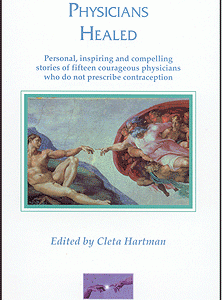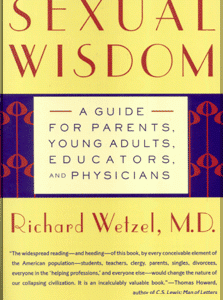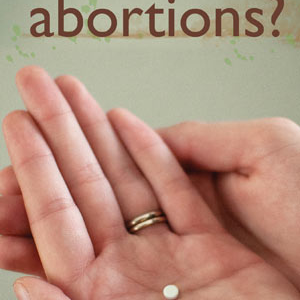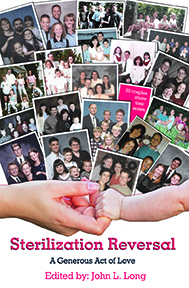By Fr William Gardner
Source: Fr. W. M. Gardner, “A Theology of Life-Giving,” HPR, Aug/Sep, 2007, pp. 68-73.
“Of Angels and Men,” is the title of an article written by Fr. Thomas Weinandy, OFM Cap., that appeared in the journal Nova et Vetera (1). Fr. Weinandy interestingly suggests that St. Thomas erred when he attributed a higher place to angels than men in the order of creation. The author, instead, holds that humans are actually more in the image and likeness of the Triune God than the angels because of their ability to give life. It is the power to give life, which the angels do not possess that allows man and woman to model the relations of the Persons of the Holy Trinity. The Father eternally begets the Son. The Holy Spirit proceeds from the Father by conforming the Father to be the loving Father of the Son. And the Holy Spirit proceeds from the Son by conforming the Son to be the loving Son of the Father. Human procreation imitates this procession of Persons within the Holy Trinity.
Furthermore, Fr. Weinandy points out that as rational creatures (like the angels), humans are given mastery and stewardship over all material creation, since they can propagate their race (unlike the angels) in a rational manner. God has entrusted mastery of the physical world (“cosmic authority”) to humans, precisely because of their power to give life according to reason and love.
The article also provides some helpful reflections about the unique roles of fatherhood and motherhood. Only the man has the power to beget. In contrast, the unique role of the woman is to be able to conceive and bear human life within herself. However, it is in their ability together to give life that the man and woman reveal that they are created in the image and likeness of the Triune God (2). Fr. Weinandy also weaves into this understanding the necessity of celibacy in the priesthood. For the priest’s iconic representation of Christ should give special emphasis to the life-giving service of preaching the Gospel and celebrating the sacraments. The priest is a life-giver too.
In summary, the beauty of this approach by Fr. Weinandy, which I would like to name a “theology of life-giving,” is that it explicitly ties the fecundity of sexual relations among created persons to the revelation of the eternal self-giving of the Persons of the Holy Trinity. Procreative love reveals Trinitarian love.
Fecundity as the Perfection of Sexual Relations
In procreation, the begetter is the one who posits (performs) the human act that has the potential to transmit human life to the begotten. The unique role of the mother is that she is the bridge of commonality, the connector, between the begetter and the begotten, so that the begetter and the begotten are of the same nature. The mother conforms the child and father to each other, inasmuch as father and child are the same kind of being. The child says to the father: “Thank you for giving me life.” While, both father and child say to the mother: “Thank you for making us one, a family.” The wife gives herself to her husband, and as mother she cooperates, provides, nurtures, gives birth… among many other irreplaceable functions. However, only the father begets life, since by making his wife to be pregnant a new person has come to be.
In other words, the act of sexual intercourse itself is directed by its nature to the potential offspring. In the case where the act is fully perfected, the woman receives the gift and unites the begetter and begotten in the bond of creative love. This is not to say, however, that the act of sexual intercourse does not have other benefits that are worth pursuing even if the procreative end is not obtained.
According to this view, the sexual act can only reach full perfection in conception. A non-fruitful act of sexual intercourse may be morally licit and mutually beneficial to the spouses and may also consummate a marital commitment (in each case, reaching a real level of perfection), but it is not a fully perfected sexual act since human life has not been transmitted. The sexual act has not achieved the end that distinguishes it from all other kinds of human acts. There is no begotten one. Perhaps this view is confirmed by Pope John Paul II when he wrote that “…fecundity is the living testimony of the full reciprocal giving of the spouses.” (Familiaris Consortio, #28)
Intercourse between persons that has the potency to transmit human life is rightly called “sexual,” for this is the end (purpose) of sexual reproduction. “Sex” produces babies. Indeed, among humans sex is the only morally licit form of procreation, since procreation is meant to be inseparable from the unifying force of life-giving love (cfr. Humanae Vitae, #12).
A Problem: The Meaning of Non-fecund Sexual Relations
If one accepts that only fruitful sexual intercourse can reach full perfection as a human act, what about couples who licitly engage in sexual relations, but are not able to conceive, either temporarily or indefinitely?
In response, their act of sexual intercourse (provided it is not tainted by contraceptive practices) reaches a real level of perfection, even if it’s not fully perfected when it’s not fecund. In other words, there may be no deficiency on their part in cultivating life-giving love, even if the act does not reach fruition. There may be no formal deficiency, only material deficiency, in the case of licit, non-fruitful sexual intercourse.
In an analogous way, there is no formal deficiency in the soul that enjoys the Beatific Vision, since the soul enjoys that vision to its full capacity. But, there is material deficiency since the body has not yet been restored to the soul. Only in the resurrection, does the soul experience the full perfection of redemption, since body and soul will have been reunited in glory. The resurrection will provide much more than an accidental augment of beatitude, since the perfection affects a restored substance; namely, an embodied soul. In a similar way, could we not say that conception (fruitfulness) is the perfection of authentic sexual, mutual self-giving? Likewise, this perfection brings a greater perception of the goodness of sexual loving and pleasure (3).
The comparison is meant to illustrate that fruitfulness is essential to the full perfection of the sexual act, even though an unfruitful sexual act can still be an essentially loving act. Similarly, the resurrection is essential to the full perfection of Beatitude, even though the soul, prior to the resurrection of the body, can have a real and meaningful participation in the Beatific Vision.
The act of unfruitful (licit) sexual intercourse is still meaningful, since it is the kind of human act that can transmit human life and has many real and worthwhile benefits, even if the procreative end is not obtained. In this case, the act is not fully perfected, but has meaning inasmuch as a life-giving kind of act has been accomplished. Indeed, such a non-fruitful act can still include a longing and desire for fruitfulness, or it may renew the joy of other acts of sexual intercourse that were fruitful at a former time.
Here it might be helpful to note that although the procreative end of sexual intercourse must be obtained for the act to be fully perfected, the institution of marriage has a wider end; namely, the mutual perfection of the spouses (cfr. Casti Coniubii, #24). This end is certainly obtainable by infertile couples, but it seems that ordinarily the most direct route to mutual perfection for spouses is through the perfection of those acts that characterize the married state.
Fueling the Motivation for a Generous Sharing of Life
The energy and unifying force of sexual relations are meant to overcome and mitigate the more arduous aspects of childbearing and raising children (4). Granted, the principle of the inseparability of the unitive and procreative meanings of sexual intercourse provides a necessary moral compass in the midst of today’s culture of death. But does this principle sufficiently inspire a calling to generous parenting in marriage?
I would like to suggest that when the perfection of sexual relations is sought and fulfilled in fecundity, there is a corresponding pleasure and energy that helps the couple to undertake the task of raising a generous number of children. The bonding effects are multiplied and the satisfaction of marital intimacy may be allowed to increase in a natural, versus a contrived, way.
Only fruitful, life-giving sexual intercourse can reach full perfection, and the energy and unifying force of sexual loving is ordered toward the transmission of human life. And as Fr. Weinandy pointed out so well, the whole process imitates the love of the Holy Trinity. Life is all about giving life!
The Role of Priests
Since priests are life-givers too, though not by virtue of begetting human life according to the flesh. And, since their life-giving is primarily affected through preaching and the celebration of the sacraments. It seems to me that priests need to be explicit in their preaching and exhortation about both the beauty of life-giving love and the duty that is incumbent upon spouses to be generously open to welcoming children. This is, in fact, a matter of duty for Catholic spouses as expressed in their dialogue with the priest at the time of their wedding: “Will you accept children lovingly from God, and bring them up according to the law of Christ and His Church?” The generous welcoming of children, in turn, can lead to a greater appreciation of the goodness and efficaciousness of sexual loving toward the end of the mutual perfection of the spouses. Thus, St. Paul’s exhortation to married couples to not withhold the marriage debt from each other (cfr. 1 Cor. 7:3-5) could also be seen as an encouragement to provide abundant posterity for one’s spouse. I believe that the rediscovery of this context of generosity, fruitfulness, and reliance on Divine Providence with regard to marital intimacy will help to reinvigorate the Church and its institutions.
It is said that the Church does not tell spouses how many children they should have (cfr. Gaudiem et Spes, #50). However, is it not also true that the Church does not specify 1, 2, or 3 children as the upward limit? Perhaps the discussion needs to be placed within the larger context of trusting God’s providence on a day-to-day basis. In other words, just as the expression… “living one day at a time” brings serenity to those who trust in God’s loving care despite the sorrows, afflictions, and anxieties of life; so also the question… “At this time, can we welcome another child into our family?” would express an openness to on-going discernment based on the events and circumstances of life, and the movements of actual grace.
Unfortunately, too often even Catholic spouses are heard to say: “We’re done!” Instead, legitimate prayerful discernment of the question should always exclude recourse to illicit means to forestall or prevent pregnancy, since there should be no hostility to the reception of new human life among God-fearing spouses (cfr. Humanae Vitae, #11). One thinks of the words of the Psalmist, who identifies the blessing of the man who fears the Lord… “You will be happy and prosper; your wife like a fruitful vine in the recesses of your home; your children like shoots of olive, around your table.” (Ps. 128).
Furthermore, Catholic preaching should aspire to lead the faithful to a greater degree of perfection. The stewardship that is so vital for the vigorous transmission of Catholic culture is that of married couples of the child-bearing age who answer the call to make a generous contribution from one’s “whole livelihood” toward the lifelong task of Christian parenting. Just as the energy and dynamic of sexual loving is naturally ordered towards procreation; so also, on the supernatural level, the spiritual inspiration and missionary zeal which are fruits of the liturgical assembly should inspire and encourage the generous reception of children within marriage (5). Hence, priests, whose duty it is to preach in season and out of season (cfr. 2 Tim. 4, 1-5), must turn the Catholic message away from pregnancy avoidance to the task of promoting a generous welcoming of children within marriage.
I believe that Catholic evangelization and preaching should encompass the effort to foster birth encouragement among married couples. If the message of contraception is that a potential life is not worth living; the message of the Catholic Church is that no human life is created by chance… and that no human life can escape the infinite and loving reach of God’s Providence (6). Furthermore, the Church proclaims that the world is always a better place when a new soul comes into existence, because of the promise and hope that each human life offers. And, our parishes, schools, communities, and nation need more children!
Marital intimacy, which is the only authentic arena of the creation of new human life, is a focal point of charity in the world and a prime arena for Catholic evangelization. For each human life can only be fully appreciated by the newness of life that Christ brings (cfr. Gaudium et Spes, #22). This is entirely a message of hope and promise for the future: let there be more children from married-couple homes… especially Catholic homes! Charity truly begins at home!
Endnotes
- “Of Angels and Men,” Nova et Vetera, Spring, 2005, Vol. 3, No. 2, pp. 295-306.
- Fr. Weinandy also addresses the possible objection to his thesis regarding the status of human beings in heaven, where they no longer exercise physical generation. Although they neither marry nor are given in marriage in heaven, they will forever carry the glorified bodily marks of having participated in life-giving love on earth, just as Christ forever bears the marks of his life-giving passion, death and resurrection, cfr. “Of Angels and Men,” pp. 303-305.
- Dante’s Inferno contains a helpful insight. In Canto Six, Virgil recalls for Dante his learning about the last judgment: “The more perfect, the more keen, Whether for pleasure’s or for pain’s discerning.” The statement was in reply to the question: Will the pain of the damned be more intense in the resurrection? The resurrection is the perfection of the particular judgment, both for the just and the wicked (cfr. The Comedy of Dante Alighieri, Cantica I, (Penguin Books, 1949), Canto VI, lines 106-108, p. 107).
- This helps to understand the importance of the virtue of chastity (purity). It also demonstrates the gravity of sins against chastity, such as: abortion and its root, contraception; cohabitation and divorce; pornography; homosexuality; and the manufacturing of human persons, all of which are diabolical (seductive and deceitful) enemies of motherhood, where motherhood represents the natural connection between sexual energy and sincere life-giving love.
- It would be interesting to explore the ramifications of a “theology of life-giving” applied to the liturgy, especially with regard to the role of the priest, who acts in the person of Christ. In one sense, the priest relates to the assembly as the Bride of Christ. In another sense, the priest relates with the assembly as the Mother of Christ, beseeching the Father that new brothers and sisters of Christ may be born in the Spirit.
- Notwithstanding the modern trends of “designer” babies and abortion-on-demand, how beautiful it would be if all Catholic families aspired to be enriched by a variety of both unplanned and planned pregnancies, in honor of our Blessed Lord himself who arrived to the Holy Family as an unplanned pregnancy.






